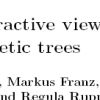| |
     
Daniel H. Huson,
Daniel C. Richter,
Christian Rausch,
Tobias Dezulian,
Markus Franz and
Regula Rupp. Dendroscope: An interactive viewer for large phylogenetic trees. In BMCB, Vol. 8:460, 2007.
Keywords: phylogeny, Program Dendroscope, software, visualization.
Note: http://dx.doi.org/10.1186/1471-2105-8-460, slides available at http://www.newton.cam.ac.uk/webseminars/pg+ws/2007/plg/plgw01/0903/huson/, software freely available from http://www.dendroscope.org.
Toggle abstract
"Background: Research in evolution requires software for visualizing and editing phylogenetic trees, for increasingly very large datasets, such as arise in expression analysis or metagenomics, for example. It would be desirable to have a program that provides these services in an effcient and user-friendly way, and that can be easily installed and run on all major operating systems. Although a large number of tree visualization tools are freely available, some as a part of more comprehensive analysis packages, all have drawbacks in one or more domains. They either lack some of the standard tree visualization techniques or basic graphics and editing features, or they are restricted to small trees containing only tens of thousands of taxa. Moreover, many programs are diffcult to install or are not available for all common operating systems. Results: We have developed a new program, Dendroscope, for the interactive visualization and navigation of phylogenetic trees. The program provides all standard tree visualizations and is optimized to run interactively on trees containing hundreds of thousands of taxa. The program provides tree editing and graphics export capabilities. To support the inspection of large trees, Dendroscope offers a magnification tool. The software is written in Java 1.4 and installers are provided for Linux/Unix, MacOS X and Windows XP. Conclusion: Dendroscope is a user-friendly program for visualizing and navigating phylogenetic trees, for both small and large datasets. © 2007 Huson et al; licensee BioMed Central Ltd."
|
|
|
|
| |
   
Leo van Iersel,
Steven Kelk,
Regula Rupp and
Daniel H. Huson. Phylogenetic Networks Do not Need to Be Complex: Using Fewer Reticulations to Represent Conflicting Clusters. In ISMB10, Vol. 26(12):i124-i131 of BIO, 2010.
Keywords: from clusters, level k phylogenetic network, Program Dendroscope, Program HybridInterleave, Program HybridNumber, reconstruction.
Note: http://dx.doi.org/10.1093/bioinformatics/btq202, with proofs: http://arxiv.org/abs/0910.3082.
Toggle abstract
"Phylogenetic trees are widely used to display estimates of how groups of species are evolved. Each phylogenetic tree can be seen as a collection of clusters, subgroups of the species that evolved from a common ancestor. When phylogenetic trees are obtained for several datasets (e.g. for different genes), then their clusters are often contradicting. Consequently, the set of all clusters of such a dataset cannot be combined into a single phylogenetic tree. Phylogenetic networks are a generalization of phylogenetic trees that can be used to display more complex evolutionary histories, including reticulate events, such as hybridizations, recombinations and horizontal gene transfers. Here, we present the new CASS algorithm that can combine any set of clusters into a phylogenetic network. We show that the networks constructed by CASS are usually simpler than networks constructed by other available methods. Moreover, we show that CASS is guaranteed to produce a network with at most two reticulations per biconnected component, whenever such a network exists. We have implemented CASS and integrated it into the freely available Dendroscope software. Contact: l.j.j.v.iersel@gmail.com. Supplementary information: Supplementary data are available at Bioinformatics online. © The Author(s) 2010. Published by Oxford University Press."
|
|
| |
    
Daniel H. Huson,
Regula Rupp,
Vincent Berry,
Philippe Gambette and
Christophe Paul. Computing Galled Networks from Real Data. In ISMBECCB09, Vol. 25(12):i85-i93 of BIO, 2009.
Keywords: abstract network, cluster containment, explicit network, FPT, from clusters, from rooted trees, galled network, NP complete, phylogenetic network, phylogeny, polynomial, Program Dendroscope, reconstruction.
Note: http://hal-lirmm.ccsd.cnrs.fr/lirmm-00368545/en/.
Toggle abstract
"Motivation: Developing methods for computing phylogenetic networks from biological data is an important problem posed by molecular evolution and much work is currently being undertaken in this area. Although promising approaches exist, there are no tools available that biologists could easily and routinely use to compute rooted phylogenetic networks on real datasets containing tens or hundreds of taxa. Biologists are interested in clades, i.e. groups of monophyletic taxa, and these are usually represented by clusters in a rooted phylogenetic tree. The problem of computing an optimal rooted phylogenetic network from a set of clusters, is hard, in general. Indeed, even the problem of just determining whether a given network contains a given cluster is hard. Hence, some researchers have focused on topologically restricted classes of networks, such as galled trees and level-k networks, that are more tractable, but have the practical draw-back that a given set of clusters will usually not possess such a representation. Results: In this article, we argue that galled networks (a generalization of galled trees) provide a good trade-off between level of generality and tractability. Any set of clusters can be represented by some galled network and the question whether a cluster is contained in such a network is easy to solve. Although the computation of an optimal galled network involves successively solving instances of two different NP-complete problems, in practice our algorithm solves this problem exactly on large datasets containing hundreds of taxa and many reticulations in seconds, as illustrated by a dataset containing 279 prokaryotes. © 2009 The Author(s)."
|
|
| |
 
Daniel H. Huson and
Regula Rupp. Summarizing Multiple Gene Trees Using Cluster Networks. In WABI08, Vol. 5251:296-305 of LNCS, springer, 2008.
Keywords: abstract network, from clusters, from rooted trees, phylogenetic network, phylogeny, polynomial, Program Dendroscope.
Note: http://dx.doi.org/10.1007/978-3-540-87361-7_25, slides from the MIEP Conference available at http://www.lirmm.fr/MIEP08/slides/11_13_rupp.pdf.
Toggle abstract
"The result of a multiple gene tree analysis is usually a number of different tree topologies that are each supported by a significant proportion of the genes. We introduce the concept of a cluster network that can be used to combine such trees into a single rooted network, which can be drawn either as a cladogram or phylogram. In contrast to split networks, which can grow exponentially in the size of the input, cluster networks grow only quadratically. A cluster network is easily computed using a modification of the tree-popping algorithm, which we call network-popping. The approach has been implemented as part of the Dendroscope tree-drawing program and its application is illustrated using data and results from three recent studies on large numbers of gene trees. © 2008 Springer-Verlag Berlin Heidelberg."
|
|
|
|
 - forked on GitHub.
- forked on GitHub.










